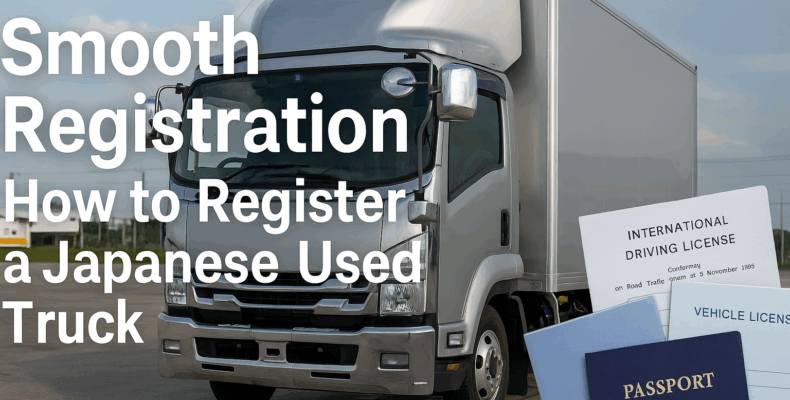Importing a Japanese used truck is just the first step. To drive it legally in your country, you must complete the registration process. Each country has its own rules, paperwork, and inspections. However, with the right documents and preparation, registering your imported truck can be simple and efficient.
In this guide, we’ll explain how to register your Japanese truck overseas, highlight key documents, and share tips to avoid costly delays.
🚚 Why Registration Matters
Without proper registration, your truck cannot legally operate. In most countries, it will also be denied insurance, road access, and resale. Moreover, incorrect paperwork may result in fines or even vehicle seizure at customs.
Fortunately, Japanese trucks—like Isuzu Elf, Hino Dutro, and Mitsubishi Fuso Canter—are well-documented and often meet international standards.
📄 Essential Documents You Need
Before you begin registration in your country, gather the following documents:
-
Export Certificate (Japanese Deregistration Paper)
-
Bill of Lading (B/L) – Proof of shipment
-
Commercial Invoice – Declares truck value
-
Emission Test Certificate – Often JEVIC or Japanese Ministry-certified
-
Odometer Inspection Certificate – Especially for used trucks
-
Customs Clearance Document – Issued by your local port authority
These documents prove that your vehicle was legally exported, properly shipped, and meets import requirements.
🌍 Registration Steps by Region
✅ Africa (e.g., Kenya, Uganda, Zambia)
-
Get a JEVIC or QISJ inspection in Japan before shipment
-
Upon arrival, present the Import Declaration Form (IDF)
-
Pay import duties, road tax, and VAT
-
Complete a roadworthiness inspection
-
Register at the National Transport Authority (NTSA) or equivalent office
In countries like Tanzania and Zimbabwe, third-party agents often assist with customs and registration.
✅ Caribbean (e.g., Jamaica, Trinidad)
-
Use a licensed customs broker to handle port clearance
-
Submit proof of ownership and VIN details
-
Pass a mechanical and emissions inspection
-
Register with the Transport Authority and obtain number plates
-
Trucks may require special permits based on weight class
✅ Middle East (e.g., UAE, Saudi Arabia)
-
Trucks must comply with GCC standards
-
Obtain a clearance certificate from customs
-
Conduct a local inspection at approved testing centers
-
Submit proof of insurance and identity
-
Register through the Ministry of Interior or Traffic Police Office
Some trucks may need modification or emissions upgrades before approval.
✅ Southeast Asia (e.g., Philippines, Myanmar)
-
Obtain a special import permit before shipment
-
Used commercial trucks often require reconditioning
-
Present JEVIC certification (if required)
-
Submit all customs documents and pay taxes
-
Register at the local Land Transport Office
In Bangladesh, a bonded warehouse system may allow delayed registration with tax incentives.
📋 Pro Tips for a Smooth Registration Process
-
Translate all documents into your local language if needed
-
Work with an experienced exporter to get correct paperwork
-
Check registration rules before shipping the truck
-
Take detailed photos of the truck’s chassis number and odometer
-
Always use a customs broker in complex countries
👉 For help choosing the right exporter, visit:
Top 5 Trusted Japanese Used Truck Exporters for Global Buyers
🧾 Frequently Asked Questions
Q1: Can I register a left-hand drive truck in a right-hand drive country?
Usually not. Always check your country’s legal requirements before import.
Q2: What if my truck fails the emissions test?
You may need to install a DPF (Diesel Particulate Filter) or pay a penalty, depending on the region.
Q3: How long does the registration process take?
It varies. In most cases, 1 to 4 weeks after customs clearance is typical.
✅ Final Thoughts
Registering a Japanese truck overseas may seem complex, but it becomes much easier with the right preparation. Start by gathering complete export documents. Then, follow your country’s local process step by step.
Choose a trusted exporter, keep all records, and be proactive with customs agents and licensing offices. Once registered, your Japanese used truck will be ready for years of productive, reliable use in your country.
